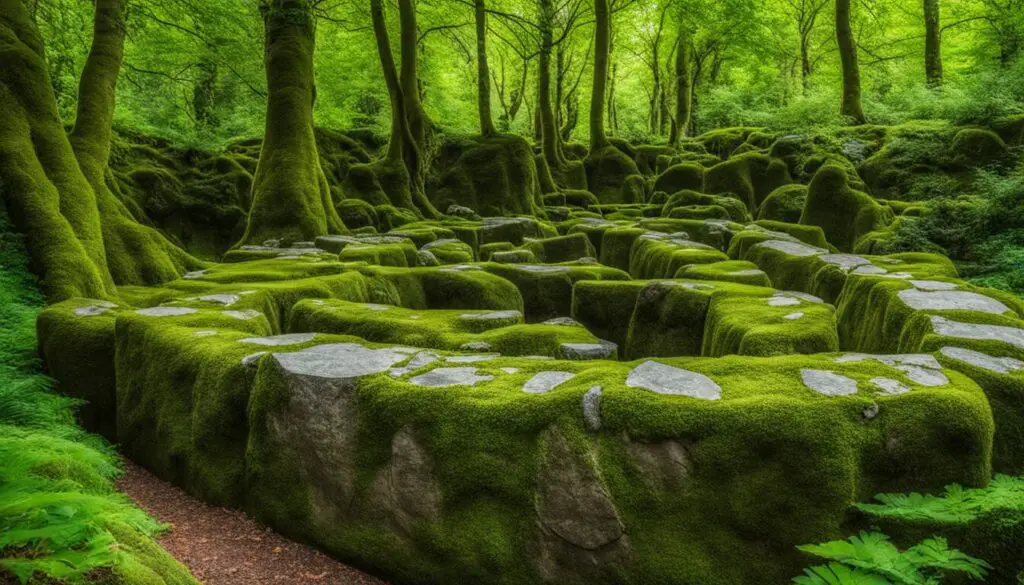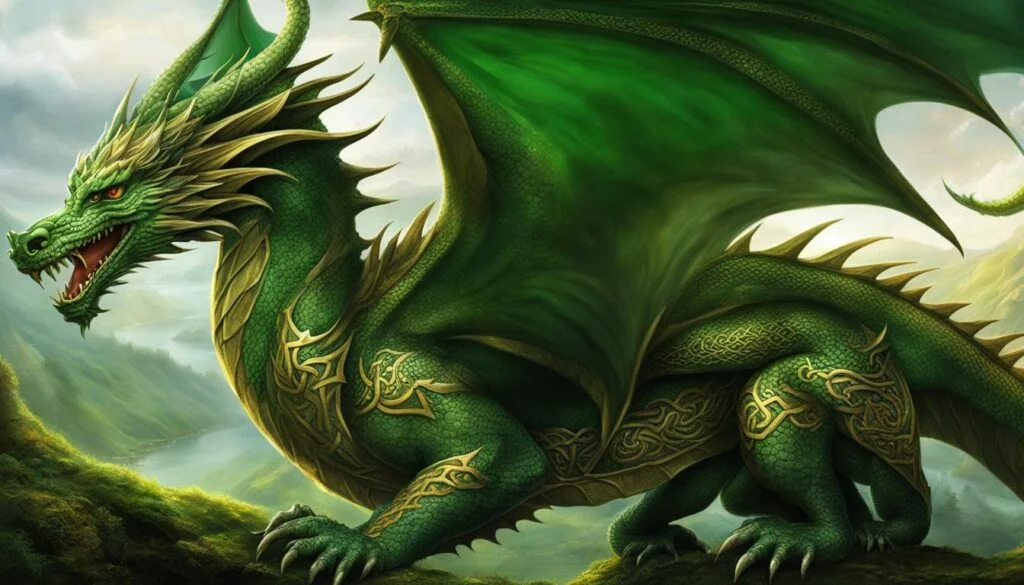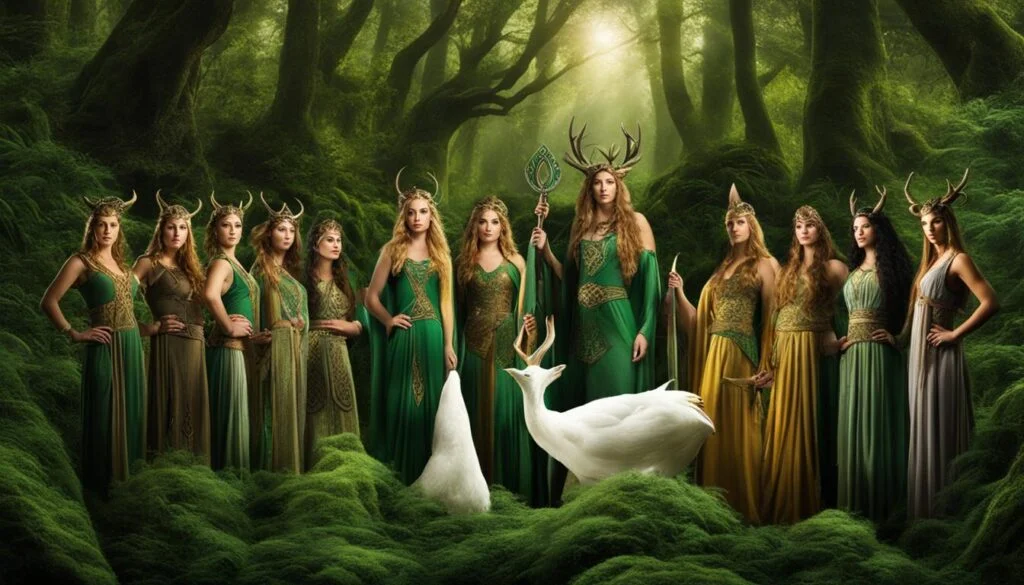Welcome to our exploration of the fascinating world of Celtic mythology and its profound impact on Ireland. Celtic mythology, specifically Irish mythology, holds a rich tapestry of ancient tales and legends that have shaped the culture, traditions, and identity of the Irish people. From the mythical cycles to the interplay between Celtic mythology and Christianity, the influence of these stories runs deep in Irish society.
Key Takeaways:
- Celtic mythology, specifically Irish mythology, has greatly influenced Irish culture and traditions.
- The Mythological Cycle, Ulster Cycle, Fenian Cycle, and Historical Cycle are significant parts of Irish mythology.
- Ancient Irish deities, heroes, and kings have shaped Irish cultural identity.
- The interplay between Celtic mythology and Christianity is evident in the tales of Irish saints.
- The connection to nature and the natural world is deeply rooted in Celtic mythology and continues to be celebrated in Irish traditions.
The Mythological Cycle: The First Settlers of Ireland
The Mythological Cycle of Irish mythology holds great significance in understanding the origins and cultural landscape of Ireland. It chronicles the arrival and disappearance of the first inhabitants of Ireland, known as the Tuatha Dé Dannan. These godlike or supernatural beings played a pivotal role in shaping the land and its people, reflecting the deep connection between mythology and the Irish cultural identity.
The myths and folklore associated with the Mythological Cycle have left an indelible mark on Irish traditions. The tales of the Tuatha Dé Dannan and other ancient Irish deities have influenced spiritual beliefs, religious practices, and even the canonization of Catholic saints. The rich tapestry of these ancient stories continues to weave its influence throughout Irish society, transcending time and shaping the collective consciousness of its people.
The Influence of Celtic Deities
- The Tuatha Dé Dannan, as depicted in the Mythological Cycle, hold significant cultural and religious importance in Ireland.
- Their stories and attributes have influenced the later canonization of Catholic saints, such as St. Patrick and St. Brigid.
- These ancient deities continue to be revered and celebrated in modern-day Ireland, showcasing the lasting impact of Celtic folklore.
Moreover, the mythology’s role in shaping Ireland goes beyond the realm of spirituality. It has influenced artistic expressions, literature, and music, serving as a source of inspiration for countless creations. The narrative themes of bravery, loyalty, honor, and the pursuit of justice found in the Mythological Cycle have become ingrained in Irish cultural practices, further reinforcing the enduring legacy of Celtic mythology.
The Mythological Cycle of Irish mythology stands as a testament to the profound impact of Celtic folklore on the cultural fabric of Ireland. It encompasses the stories of the first settlers and their supernatural counterparts, serving as a window into the ancient past and a reflection of the enduring spirit of the Irish people.
The Ulster Cycle: Tales of Ancient Heroes
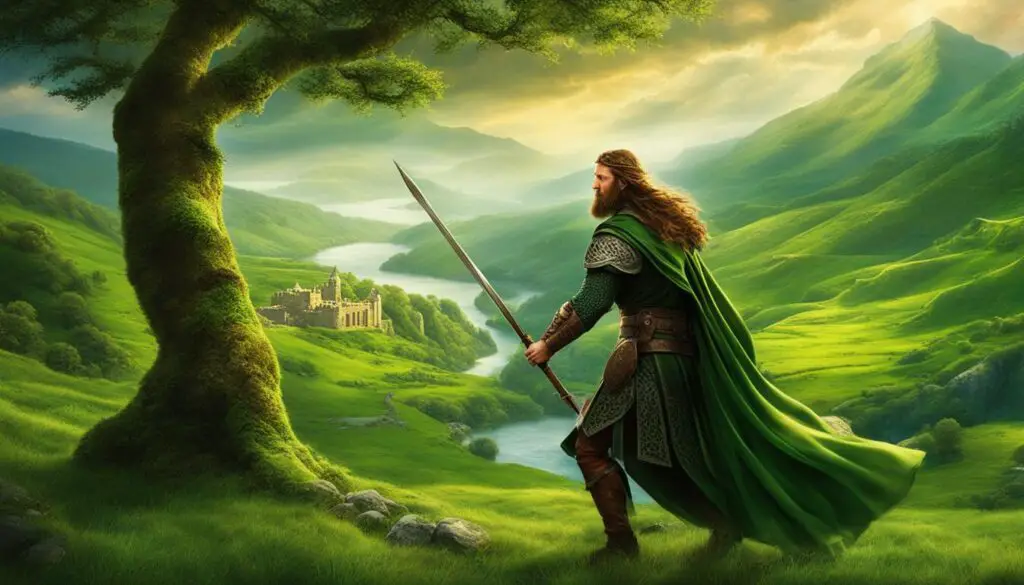
In Irish mythology, the Ulster Cycle is a collection of heroic tales that revolve around the Ulaid, a group of people occupying the northeastern province of Ulster. These captivating legends depict the ancient heroes and their epic conflicts with the Connachta, another prominent group in ancient Ireland, led by Queen Medb.
The stories of the Ulster Cycle focus on the courageous and revered figures of Ulster, particularly King Conchobar mac Nessa and the mighty hero Cú Chulainn. Their remarkable feats of strength, bravery, and honor have become integral parts of Irish folklore, shaping the cultural identity of Ireland.
Legends of Heroism and Heroic Exploits
The Ulster Cycle showcases the extraordinary heroism and heroic exploits of its characters. From the young and ferocious warrior Cú Chulainn to the honorable and wise King Conchobar, these tales capture the essence of the ancient Irish concept of heroism. The heroes demonstrate exceptional fighting skills, unwavering loyalty, and a deep sense of honor and integrity.
- Cú Chulainn’s defense of Ulster against Queen Medb’s forces
- The Táin Bó Cúailnge, the great cattle raid of Cooley
- The tragic tale of Deirdre and the Sons of Uisneach
These legends not only provide gripping narratives but also convey moral lessons and societal norms. They represent the ideal qualities and characteristics valued in ancient Irish society, such as bravery, loyalty, and honor.
Influences on Irish Legends and Culture
The tales of the Ulster Cycle have had a profound influence on Irish legends and folklore. They have been passed down through generations, contributing to the rich oral tradition of Irish mythology. The iconic figures and heroic exploits continue to inspire and captivate audiences, shaping the cultural heritage of Ireland.
Moreover, the Ulster Cycle has influenced various forms of artistic expression in Ireland, including literature, art, and music. The stories have served as sources of inspiration for countless authors, poets, and musicians, further solidifying their place in Irish culture.
The legacy of the Ulster Cycle lives on, resonating with the Irish people and reminding them of the bravery and heroism that define their cultural identity.
The Fenian Cycle: Legends of Fionn mac Cumhaill
The Fenian Cycle is a collection of ancient Irish myths and legends that revolve around the legendary hero Fionn mac Cumhaill and his band of warriors, known as the Fianna. These captivating tales have had a significant impact on Irish traditions and continue to be cherished as part of the country’s cultural heritage.
The stories of the Fenian Cycle depict the adventures, battles, and feats of bravery undertaken by Fionn mac Cumhaill and his companions. They embody the values of honor, courage, loyalty, and justice. Fionn mac Cumhaill, with his legendary wisdom and supernatural abilities, has become an iconic figure in Irish folklore, representing the indomitable spirit of the Irish people.
The Impact on Irish Traditions
- The Fenian Cycle has greatly influenced Irish storytelling, music, and literature. These tales have been passed down through generations, contributing to the rich oral tradition of Irish mythology.
- Characters from the Fenian Cycle, such as Fionn mac Cumhaill and his legendary warriors, continue to inspire and captivate audiences in contemporary Irish literature and art.
- The values and themes portrayed in the stories, such as bravery, loyalty, and the pursuit of justice, have had a lasting impact on Irish cultural practices and traditions.
The Enduring Legacy
The Fenian Cycle remains a beloved part of Irish culture, with its stories continuing to be celebrated and retold at festivals and gatherings. The tales capture the imagination and spirit of the Irish people, connecting them to their ancient roots and preserving their cultural identity.
The Historical Cycle: The History of Ancient Irish Royalty
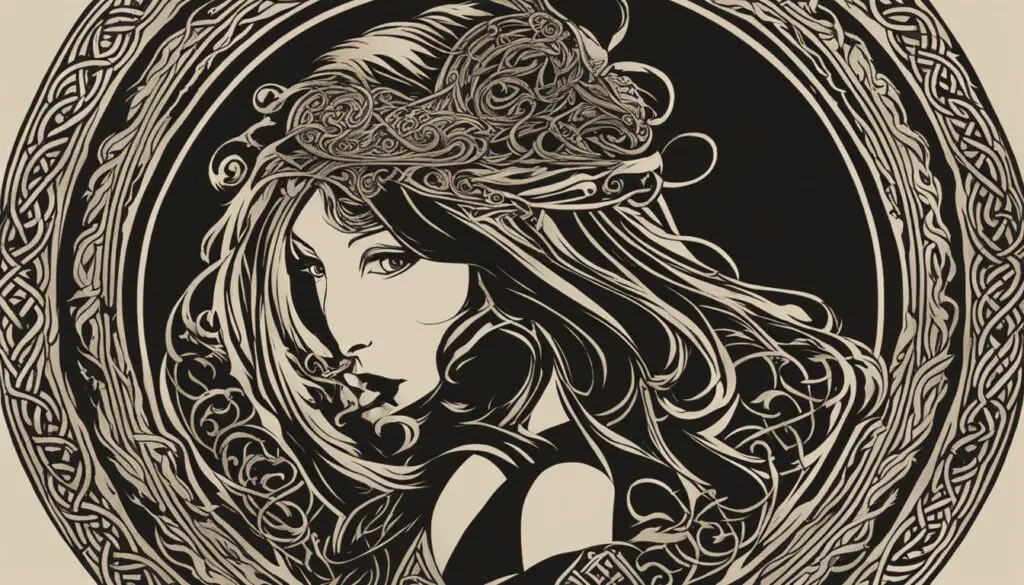
In Irish mythology, the Historical Cycle, also known as the Cycle of the Kings, offers a glimpse into the rich history and genealogy of ancient Irish royalty. These tales, passed down through generations by court poets, provide valuable insights into the political and social structures of ancient Ireland. They paint a vivid picture of the importance of lineage, power, and the role of kings in Irish society.
Throughout the Historical Cycle, legendary kings and queens of Ireland are depicted, showcasing their triumphs, challenges, and the impact they had on shaping the island’s history. These stories not only celebrate the achievements of these rulers but also serve as cautionary tales, illustrating both the potential for greatness and the consequences of their actions.
The Role of Kings
The stories within the Historical Cycle highlight the significant role played by Irish kings in governing the land and maintaining order. They showcase the responsibilities and challenges faced by these rulers, from making difficult political decisions to defending their territories against rival clans and external threats. The tales provide valuable insights into the complexities of power dynamics in ancient Ireland and the strategies employed by kings to navigate these intricate webs of allegiances and rivalries.
Historical Influence
The Historical Cycle has had a profound influence on Irish traditions and cultural practices surrounding monarchy and leadership. These tales have contributed to the romanticization of ancient Irish royalty and the associated concepts of honor, valor, and the pursuit of justice. The stories continue to shape how the Irish view their history and heritage, providing a sense of connection to their ancestors and a deeper understanding of the country’s roots.
- Key elements of the Historical Cycle have been preserved in Irish folklore, art, literature, and music, helping to solidify their place in Irish cultural identity.
- They serve as a reminder of the importance of preserving and sharing historical narratives to ensure the legacy of past generations is not forgotten.
- The Historical Cycle also underscores the resilience of Irish culture and its ability to adapt and evolve while maintaining a strong connection to its ancient heritage.
The Influence of Celtic Mythology on Irish Culture
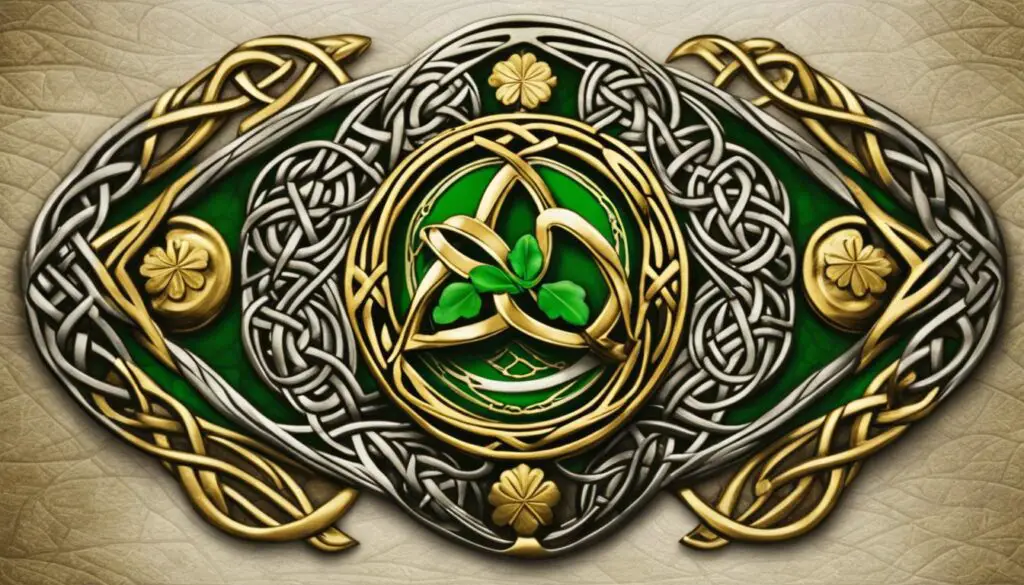
Celtic mythology, particularly Irish mythology, has had a profound influence on Irish culture. The tales and legends of ancient Irish deities, heroes, and kings have shaped the cultural identity of Ireland. These captivating stories have been passed down through generations, becoming an integral part of Irish folklore and contributing to the rich cultural heritage of the Irish people.
One of the significant ways in which Celtic mythology has influenced Irish culture is through its impact on art, literature, and music. Artists, writers, and musicians have drawn inspiration from the mythical characters and themes, creating works that reflect the magic and mysticism of Irish mythology. From traditional Irish music that tells the stories of ancient heroes to iconic literary works like James Joyce’s “Finnegans Wake,” Celtic mythology has provided a wellspring of creativity for generations of Irish artists.
Celtic mythology has also played a role in shaping religious practices in Ireland. The blending of Celtic mythology and Christianity is evident in the stories of Irish saints, such as St. Patrick and St. Brigid. These saints’ lives and miracles often incorporate elements of ancient Irish deities and folklore, demonstrating how the old and the new belief systems coexist in Irish religious traditions.
Furthermore, Irish cultural practices surrounding nature and the natural world have been deeply influenced by Celtic mythology. The ancient Celts revered nature and believed in the spiritual presence of non-human entities. This reverence for the natural world is still evident in Irish traditions today, such as the celebration of the summer solstice at ancient sacred sites like Newgrange.
The Influence of Celtic Mythology on Irish Culture:
- Significant influence on art, literature, and music
- Blending of Celtic mythology and Christianity in religious practices
- Deep connection to nature and the natural world
The Interplay Between Celtic Mythology and Christianity in Ireland
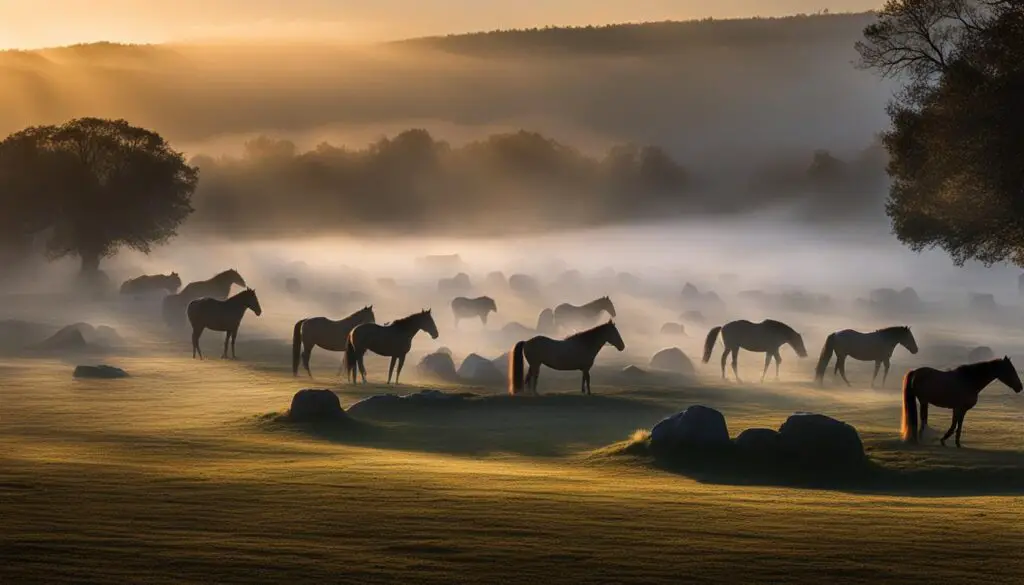
The arrival of Christianity in Ireland brought about a fascinating interplay between Celtic mythology and Christian beliefs. The ancient myths and legends of the Celtic people were deeply ingrained in Irish culture, and with the introduction of Christianity, these two belief systems began to merge and intertwine.
Christian monks in the 11th century took on the task of recording the rich oral tradition of Irish mythology. In doing so, they often incorporated elements of Christian faith into the stories, creating a unique blend of Celtic folklore and Christian symbolism. This blending can be seen in the tales of Irish saints, such as St. Patrick and St. Brigid, who were influenced by ancient Irish deities.
The coexistence of Celtic folklore and Christian faith in Ireland is a testament to the lasting impact of Celtic mythology on the cultural and religious practices of the Irish people.
The interplay between Celtic mythology and Christianity in Ireland is most evident in the adoption of certain pagan customs and rituals into Christian practices. For example, the celebration of the spring equinox, known as Ostara in Celtic mythology, was transformed into the Christian holiday of Easter. Similarly, the festival of Samhain, which marked the end of the harvest season and the beginning of winter, became All Hallows’ Eve, or Halloween, in Christian tradition.
This blending of Celtic mythology and Christianity reflects the adaptability and resilience of Irish culture. Rather than erasing or rejecting their ancient beliefs, the Irish people found a way to incorporate them into their newfound faith. This interplay between Celtic mythology and Christianity continues to shape Irish culture to this day, with traditions and customs that honor both the old and the new.
- The arrival of Christianity in Ireland led to an interplay between Celtic mythology and Christian beliefs.
- Christian monks recorded Irish myths, incorporating Christian elements into the stories.
- This blending of Celtic folklore and Christian faith is evident in the tales of Irish saints.
- The coexistence of Celtic mythology and Christianity is seen in the adoption of pagan customs into Christian practices.
- This interplay reflects the adaptability and resilience of Irish culture.
The Role of Nature in Celtic Mythology and Irish Culture
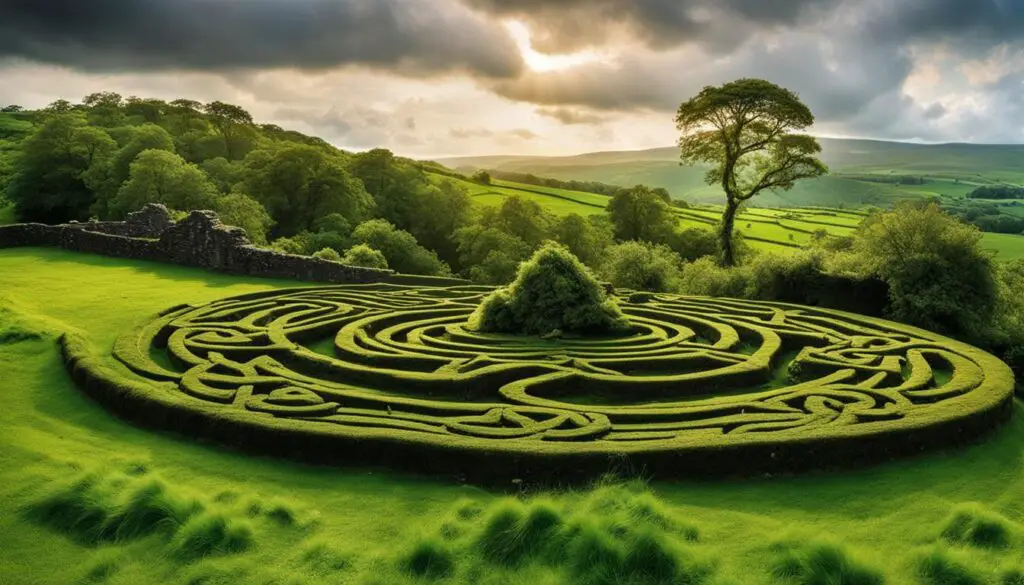
Celtic mythology, including Irish mythology, holds a deep reverence for the natural world. Nature is not only seen as a source of sustenance and beauty but as a realm inhabited by spiritual beings. This belief in the spiritual essence of nature, known as animism, shaped the Celtic worldview and continues to impact Irish culture and traditions today.
In Celtic mythology, the forces of nature are personified as deities, embodying the power and mysteries of the natural world. From the mighty seas to the ancient forests, each element of nature holds significance and symbolism. For example, the goddess Brigid is associated with fertility, healing, and the transformative power of fire, while the god Lugh represents the sun and the harvest.
The connection between nature and Irish culture is further evident in the belief in the Otherworld, an ethereal realm parallel to our own. In Celtic mythology, sacred sites such as wells, trees, and hills are believed to be gateways to this Otherworld, where supernatural beings reside. These places are treated with great reverence and are often sites of pilgrimage and ritual in Irish traditions.
The Impact on Irish Traditions
- Irish festivals and celebrations, such as Samhain and Beltane, are deeply rooted in Celtic mythology and nature worship.
- The respect for nature is reflected in environmental conservation efforts and sustainable practices in modern-day Ireland.
- The folklore and legends surrounding nature in Irish mythology continue to inspire art, literature, and music.
- Many traditional Irish names are derived from nature and mythology, reaffirming the significance of these themes in Irish culture.
The influence of nature in Celtic mythology is a testament to the enduring connection between the Irish people and the land they inhabit. It shapes their beliefs, values, and understanding of the world around them. From the majestic landscapes to the tales of supernatural beings, the role of nature in Celtic mythology continues to enrich and define Irish culture.
Conclusion
Celtic mythology has had an immense influence on Ireland, shaping its culture, traditions, and identity. The tales and legends of ancient Irish deities, heroes, and kings have become an integral part of Irish folklore, passing down from generation to generation and enriching the cultural heritage of the Irish people.
The interplay between Celtic mythology and Christianity further demonstrates the lasting impact of these ancient tales on Irish culture. Christian monks recorded many Irish myths and legends, incorporating elements of Christian faith into the stories. This blending of Celtic mythology and Christianity is evident in the tales of Irish saints, such as St. Patrick and St. Brigid, who were influenced by the ancient Irish deities.
Additionally, the deep connection to nature in Celtic mythology has left an indelible mark on Irish culture. The ancient Celts revered and honored the forces of nature, and this animistic worldview influenced the Irish people’s respect for sacred spaces and their belief in the supernatural presence of the Otherworld.
Today, the celebration and preservation of Celtic mythology in modern-day Ireland showcase the continued cultural impact of these ancient tales. The stories of the gods, heroes, and kings continue to inspire art, literature, music, and religious practices, solidifying the significant role that Celtic mythology plays in Irish cultural heritage.
FAQ
How did Celtic mythology influence Ireland?
Celtic mythology, particularly Irish mythology, has had a profound influence on Irish culture, shaping its traditions, identity, and beliefs.
What is the Mythological Cycle?
The Mythological Cycle is the oldest cycle of Irish mythology and tells the stories of the supernatural first inhabitants of Ireland, known as the Tuatha Dé Dannan.
What is the Ulster Cycle?
The Ulster Cycle consists of heroic legends that focus on the mythical Ulster king Conchobar mac Nessa and the hero Cú Chulainn.
What is the Fenian Cycle?
The Fenian Cycle recounts the journey of the hero Fionn mac Cumhaill and his mighty warriors, known as the Fianna.
What is the Historical Cycle?
The Historical Cycle, also known as the Cycle of the Kings, chronicles the history and genealogy of ancient Irish royalty.
How did Celtic mythology influence Irish culture?
Celtic mythology, including Irish mythology, has shaped the cultural practices, traditions, and beliefs of the Irish people.
How did Celtic mythology interact with Christianity in Ireland?
Christian monks in the 11th century recorded many Irish myths and legends, often incorporating elements of Christian faith into the stories, blending Celtic mythology and Christianity.
What role does nature play in Celtic mythology and Irish culture?
Celtic mythology places a strong emphasis on nature, influencing the Irish people’s deep connection to the land and their respect for sacred spaces.
What is the overall impact of Celtic mythology on Ireland?
Celtic mythology has had a lasting impact on Ireland, shaping its culture, traditions, and identity, which continue to be celebrated and honored in modern-day Ireland.


